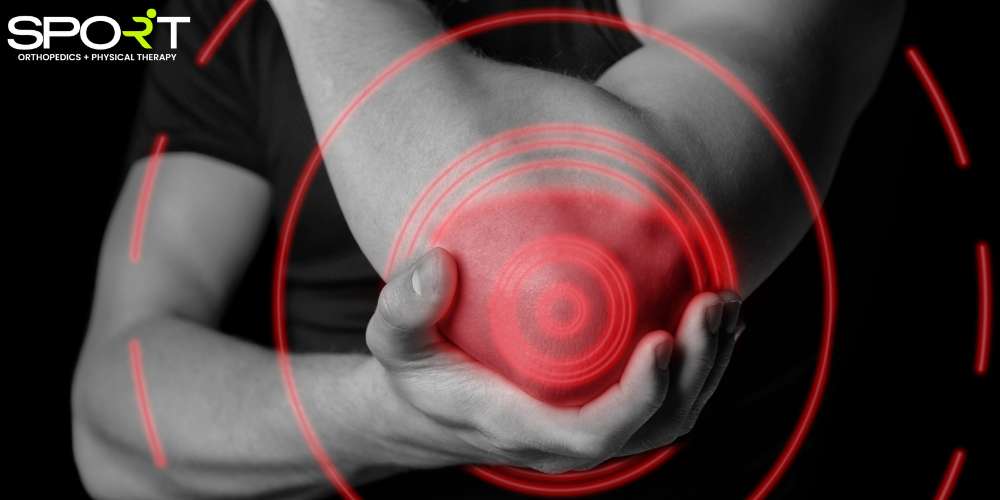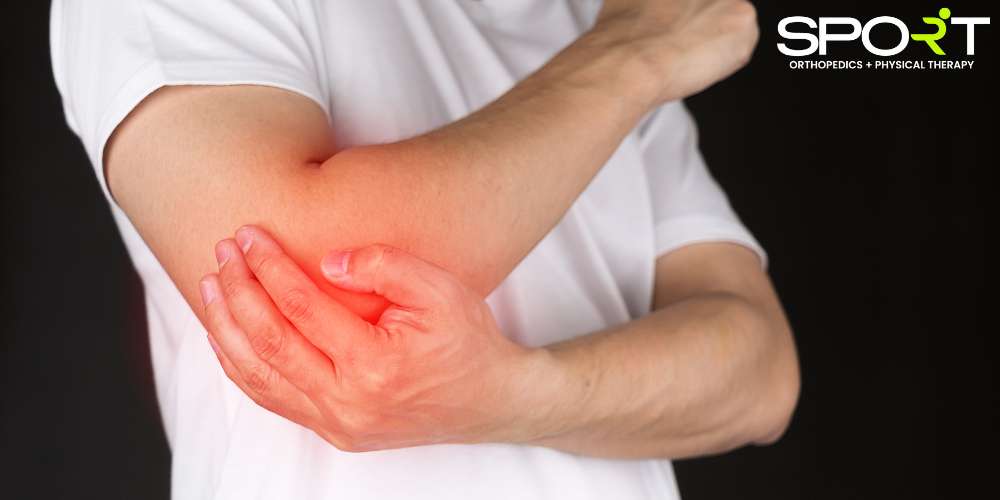Do You Have Elbow Pain When Lifting Weights?
Elbow pain while lifting weights shouldn’t be a regular occurrence. It’s important to not only identify the source of your pain, but also to treat it as soon as possible. If you experience pain or tennis elbow from lifting weights, you need an experienced orthopedic specialist in Dallas to help. Medical professionals who often treat sports injuries and overuse injuries are best suited to meet your needs.
At SPORT Orthopedics + Physical Therapy, we prioritize comfort and fast recoveries for our patients. If you live an active lifestyle, you probably don’t want to be restricted and recovering for longer than necessary. That’s why it’s important to contact SPORT as soon as possible. Our Dallas physical therapists and orthopedic doctors have the knowledge and experience to treat a wide range of conditions. To schedule an appointment with an elbow specialist, please call 469-200-2832 or fill out our online intake form today.
Overview of Elbow Anatomy
The radius, ulna, and humerus are the three bones that make up the elbow. The joint is additionally held together by muscles, ligaments, and tendons. Epicondyles are two bony bumps at the bottom of the humerus that link the forearm muscles and tendons to the elbow. The lateral epicondyle is located on the outside of the elbow, whereas the medial epicondyle is located on the inside.
The elbow joint allows for four primary functions: flexion, extension, supination, and pronation. Golfer’s elbow and tennis elbow are two of the most common injuries sustained by those doing strength training exercises. Golfers and tennis players aren’t the only ones affected by these conditions, despite their names.
Types of Elbow Pain from Lifting Weights
While elbow pain from lifting often resolves on its own, it frequently manifests differently in different patients depending on the underlying causes of the pain. For example, some patients experience severe inner elbow pain (medial elbow pain), while others have pain that is more concentrated on the outer elbow.
In the following sections, we describe several different types of elbow pain that patients can experience from lifting weights.
Inside Elbow Pain When Lifting Weights
Inner elbow pain, also known as medial epicondylitis or “golfer’s elbow,” occurs on the inner side of the elbow and is often caused by overuse of the forearm muscles that enable wrist and finger flexion. This condition is commonly seen in weight lifters due to repetitive stress from lifting and gripping activities, leading to inflammation and microtears in the tendons attached to the medial epicondyle.
Outer Elbow Pain from Lifting Weights
Outer elbow pain, known as lateral epicondylitis or “tennis elbow,” affects the tendons on the outside of the elbow. This pain arises from repetitive overuse and strain on the extensor muscles of the forearm, which are involved in extending the wrist and fingers. Lifting weights, particularly during exercises that require a strong grip or involve wrist extension, can exacerbate this condition. Experiencing elbow pain while lifting weights is not an uncommon occurrence.
Elbow Pain When Lifting Light Objects
Experiencing elbow pain even when lifting light objects can be indicative of a more chronic or severe underlying condition, such as tendinitis or tendinosis. This persistent pain suggests that the elbow tendons and muscles may have undergone significant wear and tear, leading to prolonged inflammation or degeneration. It highlights the importance of proper technique and adequate rest in preventing a repetitive stress injury caused by overuse.
Elbow Pain When Lifting and Gripping
Elbow pain during lifting and gripping often stems from tendinitis, where the tendons in the elbow become inflamed due to repetitive strain. This type of pain can affect both the medial and lateral sides of the elbow, depending on the specific tendons involved. The pain usually intensifies with activities that require a strong grip or involve significant lifting, indicating strain on the tendon attachments to the elbow muscles around the joint.
Pain in Forearm When Lifting and Gripping
Sometimes, pain in the upper arm bone or forearm can accompany pain in the elbow. Forearm pain associated with lifting and gripping activities can be due to muscle strain, tendinitis, or nerve compression. The forearm muscles, which play a critical role in gripping and lifting, can become overworked and strained, leading to pain. Conditions like forearm tendinitis or cubital tunnel syndrome, where the ulnar nerve is compressed, can cause pain radiating from the elbow down into the forearm, particularly during strenuous activities.
What Causes Elbow Pain While Lifting Weights?

Although chest, triceps, and shoulder movements may all exert strain on the elbow, incorrect bicep curls are the most prevalent cause of golfer’s elbow and tennis elbow from lifting weights. If you’re having trouble with your inner or outer elbows, it might be due to one or more frequent bicep curl form faults. It’s crucial to understand when to consult a doctor for your elbow injury if the discomfort doesn’t go away after you’ve corrected your technique. It is possible that you experienced a serious injury, such as a UCL tear.
Common Reasons for Elbow Pain From Bicep Curls
As with many exercises, there are right and wrong ways to do them. In terms of form, it’s crucial to ensure that you maintain certain positions while exercising. These forms exist to lessen the chance of injury and to put the least amount of strain on your body. Below, we list four ways that people develop elbow pain from lifting weights.
Gripping Too Tightly
The flexor tendon, which lets your wrist bend or flex forward, activates when you grasp the bar or dumbbell too tightly. Even if your wrist remains neutral during the curl, stimulating the flexor tendon in this manner can result in inner elbow soreness and golfer’s elbow.
Poor Wrist Positioning
Letting your wrists move forward, similar to gripping the bar or dumbbell too tightly, can stimulate the flexor tendon and cause inner elbow discomfort. When you stretch or flex your wrists back during a curl, the weight activates the extension tendons in your wrists, which are related to the outer side of your elbow. This causes outside elbow discomfort and tennis elbow.
Too Much Weight
Though it may be self-evident, it is a little more complicated than you may imagine. It’s possible that using too much weight for your bicep curl has little to do with the strength of your biceps and everything to do with your grip and strength or your forearms.
Inner and outer elbow discomfort can be caused by holding too firmly or extending or bending your wrist during a bicep curl, as previously discussed. If you over-hold the bar or dumbbells due to a lack of muscular strength, or if your forearm strength causes flexion or extension of the wrist, the weight is likely too heavy for you to curl while maintaining perfect form. Elbow discomfort and damage can result from poor form.
Not Enough Variation
Bicep curls come in 12 different varieties, according to the International Sports Sciences Association. What is the significance of this? Because overuse injuries are caused by repetition. When you practice the same types of bicep curls over and over again, the same stresses are applied to your arms and elbows. Tennis elbow or golfer’s elbow can result from this. It’s critical to diversify your strength training workouts to avoid repeated stress injuries.
What Is Tennis Elbow?

Tennis elbow affects the Extensor Carpi Radialis Brevis muscle (ECRB). The movement of the wrists and fingers is controlled by this forearm muscle. The extensors (forearm tendons) are the tendons that connect these muscles to bones. Microscopic rips in the extensor can occur where it joins to the lateral epicondyle when the ECRB is compromised by overuse. Tennis elbow is the result of this, which causes discomfort and inflammation.
Tennis elbow (lateral epicondylitis) may require arthroscopic elbow surgery if the condition progresses too far. This is why it is so important for patients to seek medical attention sooner rather than later.
What Is Golfer’s Elbow?
Similarly to tennis elbow, golfer’s elbow, also termed medial epicondylitis, affects the other side of the elbow. Golfer’s elbow is a repeated stress injury that results from injury to the muscles and tendons that attach to the medial epicondyle, causing significant inner elbow discomfort.
What Is Weightlifters Elbow?
Weightlifter’s elbow is a term used to describe chronic elbow pain experienced by individuals who frequently engage in weightlifting and strength training. It encompasses a range of conditions, including both tennis elbow and golfer’s elbow. It is characterized by inflammation and microtears in the tendons around the elbow due to repetitive overuse and heavy lifting.
How to Treat Tennis Elbow from Lifting Weights
Unlike a Tommy John injury or other severe damage to the elbow, tennis elbow (lateral epicondylitis) from lifting weights rarely requires any kind of surgical intervention. More serious injuries sometimes require elbow replacement surgery (elbow arthroplasty) or tennis elbow surgery.
Non-surgical treatment options and physical therapy sessions usually suffice for tennis elbow. In fact, many doctors prescribe RICE, or rest, ice, compression, and elevation. They might also recommend anti-inflammatory medication.
If you make adjustments to your repetitive weight lifting and follow the treatment recommendations, your pain should subside. However, if the pain lasts longer than 12 months, we recommend calling your doctor. It might be time for a steroid injection or a surgical option. As stated before, it is not common to undergo surgery for tennis or golfer’s elbow. However, it is still a possibility in severe cases.
Elbow Pain Treatment
Tennis elbow normally heals on its own, which is the good news regarding treatment. All you have to do now is rest your elbow and do whatever you can to hasten the healing process. The following are some of the types of treatments that can help.
How to Relieve Elbow Pain from Lifting Weights
- Ice your elbow. This reduces both pain and swelling. Most orthopedic specialists recommend icing the area for twenty to thirty minutes every 3 to four days. Repeat this for a few days, or until the pain subsides.
- Use an elbow strap. This protects the affected tendons from suffering more strain.
- Take NSAIDs. Examples include aspirin, naproxen, and ibuprofen. These help with both pain and swelling. However, remember that taking these medications for too long can result in stomach bleeding and ulcers.
- Practice range of motion exercises. These help to reduce stiffness in the elbow, as well as to increase flexibility. Some doctors recommend doing these exercises as many as five times a day, depending on your situation.
- Attend physical therapy. Consulting with a skilled physical therapist can help to both strengthen and stretch your muscles.
- Steroid or painkiller injections. These will only temporarily ease the pain in your joints. In fact, some studies report that, in the long term, they don’t really help.
In most cases, the above nonsurgical solutions are effective. Unfortunately, severe cases might warrant a more invasive approach. Some doctors recommend arthroscopic elbow surgery after around 4 months of ineffective conservative treatments. During surgery, your doctor will remove the damaged portion of the affected tendon. Then, they repair the rest of the tendon.
How to Prevent Tennis Elbow from Lifting Weights
Avoiding overuse is the key to avoiding tennis elbow. If you experience any elbow discomfort while participating in an activity, you should stop. Tennis elbow can also be caused by using the incorrect equipment, such as a golf club or tennis racket that is excessively heavy or has a handle that is too big. Tennis elbow can also be caused by poor technique, such as swinging with the improper posture. You should also keep the following tips in mind to prevent elbow pain.
- Always warm up before playing sports or engaging in any type of physical activity. This is especially important when it comes to your arms and legs, as they’ll likely be moving more than the rest of your body.
- Ice your elbows after you exercise. Just as it’s necessary to warm up before an exercise, it’s important to cool off afterward. This helps with any swelling or soreness that might occur.
- Avoid repetitive movements as much as you can. If you’re performing a task where repetition is necessary, take occasional breaks. Also take breaks if you feel pain.
What Upper Body Exercises Can I Do With Tennis Elbow?

We know that feeling limited in your exercise routine can be frustrating. Sometimes, patients ask us what upper body exercises they can do while recovering from tennis elbow. To avoid repetitive stress injuries in your elbow, you should still be able to perform the following exercises. Of course, we always recommend consulting with a Dallas physical therapist to ensure that you do not aggravate any existing injuries further.
Chest Exercises
- Modified push-ups: Modify regular push-ups by doing them on your knees or against a wall to reduce elbow strain.
- Chest press: Use lighter weights or resistance bands and ensure a neutral wrist position.
Back Exercises
- Seated rows: Use a machine with lighter weights or resistance bands, keeping your wrists neutral.
- Lateral pulldowns: Perform these with a wide grip to reduce forearm strain.
Shoulder Exercises
- Shoulder press: Use lighter dumbbells or resistance bands, keeping your wrists straight.
- Lateral raises: Use lighter weights and perform slow, controlled movements.
Arm Exercises
- Bicep curls: Use lighter weights or resistance bands. Consider using an arm brace for added support.
- Tricep extensions: Perform with caution, using lighter weights and focusing on form.
Core Exercises
- Planks: Modify by doing forearm planks to avoid wrist strain.
- Crunches and sit-ups: Avoid any gripping motions that could exacerbate the elbow condition.
Contact SPORT Orthopedics + Physical Therapy Today
At SPORT Orthopedics + Physical Therapy, we take pride in the quality of care we offer our patients. From total hip replacement surgery to minor elbow arthroscopy, we offer a wide range of treatment options. An orthopedic surgeon Frisco with our practice has years of experience diagnosing and treating a wide range of conditions. To schedule an appointment with an orthopedic elbow specialist, please call 469-200-2832 or fill out our online intake form today.



